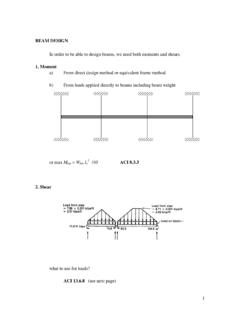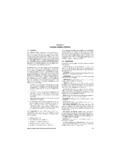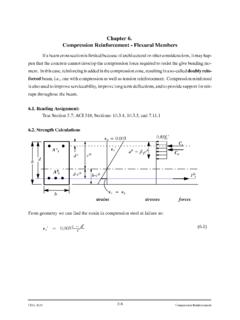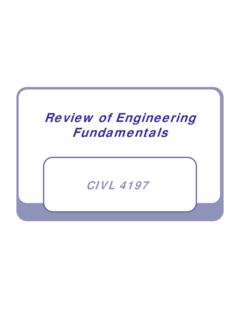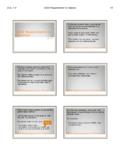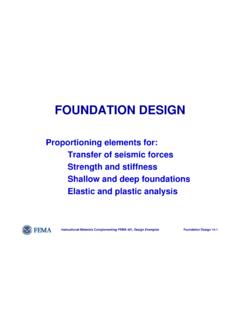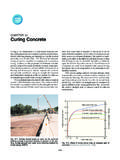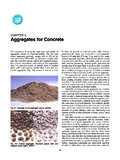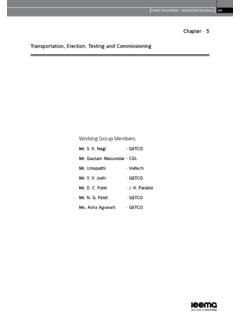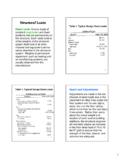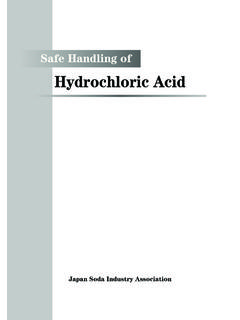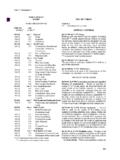Transcription of Live Loads for Bridges - The University of Memphis
1 live Loads for Bridges In our previous discussions we mentioned that the primary live Loads on bridge spans are due to traffic. The heaviest Loads are those produced by large transport trucks. The American Association of State and Highway Transportation Officials (AASHTO) has a series of specifications for truck loadings. live Loads for Bridges For two-axial trucks AASHTO designates these vehicles as H series trucks. For example, a H15-44 is a 15-ton truck as reported in the 1944 specifications. Trucks that pull trailers are designated as HS, for example HS 20-44 (a 20-ton semi-trailer truck). In general, a truck loading depends on the type of bridge , its location, and the type of traffic Loads for Bridges The size of the standard truck and the distribution of its weight is reported in the AASHTO code. The H loading consists of two-axial truck The number following the H designation is the gross weight in tons of the standard truckH 20-44 8 kips32 kipsH 15-44 6 kips24 W14 feetW = Total weight of truck and loadLive Loads for Bridges The HS loading consists of tractor truck with semi-trailer The number following the HS designation is the gross weight in tons of the standard truckHS20-44 8 kips32 kips32 kipsHS15-44 6 kips24 kips32 kipsLive Loads for BridgesThe AASHTO standard H20 and HS20 trucks live Loads for BridgesThe AASHTO specifications also allow you to represent the truck as a single concentrated load and an uniform load .
2 For H20-44 and HS20-44: concentrated load18 kips for moment26 kips for shear Uniform loading640 lb/ft of load laneCIVL 3121 Influence Lines - Part 31/5 live Loads for BridgesThe AASHTO specifications also allow you to represent the truck as a single concentrated load and an uniform load . For H15-44 and HS15-44: concentrated kips for kips for shear Uniform loading480 lb/ft of load laneLive Loads for Bridges You can probably see that once the loading has been selected, you have to determine the critical position of the truck on the structure ( bridge ). This is an excellent application for influence lines. live Loads for Bridges In many cases, vehicles may bounce or sway as they move over a bridge . This motion produces an impactload on the bridge . AASHTO has develop an impact factorto increase the live load to account for the bounce and sway of vehicles. where L is the length of the span in feetLive Loads for BridgesImpact loading is intended to transfer Loads from the superstructure to the substructure Superstructures including legs of rigid frames Piers excluding footings and those portions below ground line Portions above ground line of concrete and steel piles that support the super structureLive Loads for BridgesImpact shall not be included in Loads transferred to footings or to those parts of piles or columns that are below ground Abutments, retaining walls, piles excepts as specified before Foundation pressures and footings Timber structures Sidewalk Loads Culverts and structures having 3 feet or more of cover14 k32 k8 kLive Loads for BridgesExample.
3 Consider our standard AASHTO HS20-44 truck traveling over the span of some 3121 Influence Lines - Part 32/5 live Loads for Bridges Shear- To examine how a series of concentrated Loads effect the shear lets consider our standard truck and its effect on the shear at point C on the beam shown above. First we need the influence line for the shear at point C. ABC50 the Muller-Breslau principle construct the influence line for the shear at point CVVCxVThe change in shear is equal to 1 live Loads for k32 k8 k Let s try to find the maximum positiveshear at point C. There are three cases to examine, one for each of the three wheel forces as they pass over the point C . live Loads for BridgesABCase # 18 ( ) 32 ( ) 32 ( )CCaseVkk k 14 k32 k8 k Let s try to find the maximum positiveshear at point C. There are three cases to examine, one for each of the three wheel forces as they pass over the point C . live Loads for BridgesABCase # 28 ( ) 32 ( ) 32 ( )CCaseVk kk 14 k32 k8 k Let s try to find the maximum positiveshear at point C.
4 There are three cases to examine, one for each of the three wheel forces as they pass over the point C . live Loads for BridgesABCase # 38 ( ) 32 ( ) 32 ( )CCaseVk k k live Loads for Bridges The maximum positive shear at point C is Let s rework the previous problem to find the maximum negativeshear at point C. There are three cases to examine, one for each of the three wheel forces as they pass over the point C. In this case, use the largest negativevalue from the influence lineCIVL 3121 Influence Lines - Part 33/514 k32 k8 k Let s try to find the maximum negativeshear at point C. There are three cases to examine, one for each of the three wheel forces as they pass over the point C . live Loads for BridgesABCase # 18 ( ) 32 ( ) 32 ( )CCaseVk k k 14 k32 k8 k Let s try to find the maximum negativeshear at point C. There are three cases to examine, one for each of the three wheel forces as they pass over the point C.
5 live Loads for BridgesABCase # 28 ( ) 32 ( ) 32 ( )CCaseVk k k 14 k32 k8 k Let s try to find the maximum negativeshear at point C. There are three cases to examine, one for each of the three wheel forces as they pass over the point C . live Loads for BridgesABCase # 38 ( ) 32 ( ) 32 ( )CCaseVk k k live Loads for Bridges The maximum negativeshear at C is In this case, the largest shear at C is the largest negativevalue, or Vmax= k32 k8 kABLive Loads for BridgesExample: Determine the maximum moment created at point B in the beam below due to the wheel Loads of a moving truck. The truck travels from right to left. 100 k5 k12 Loads for BridgesExample: Determine the maximum shear created at point C in the beam below due to the wheel Loads of a moving truck. The truck travels from right to left. 2 mA6 mABC1 kN4 kN6 kN1 m3 mCIVL 3121 Influence Lines - Part 34/5 End of Influence Lines - Part 3 Any questions?
6 CIVL 3121 Influence Lines - Part 35/5
